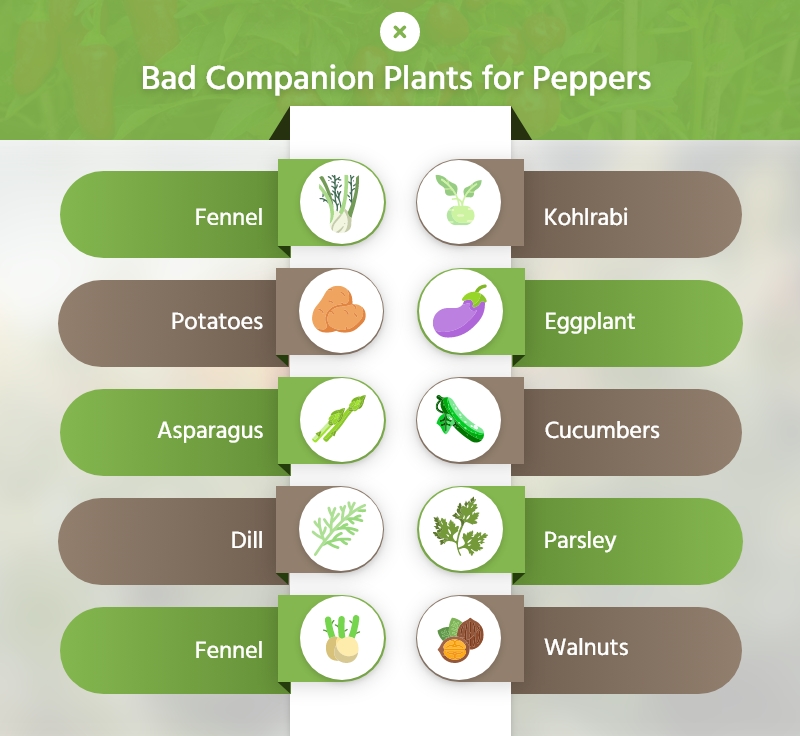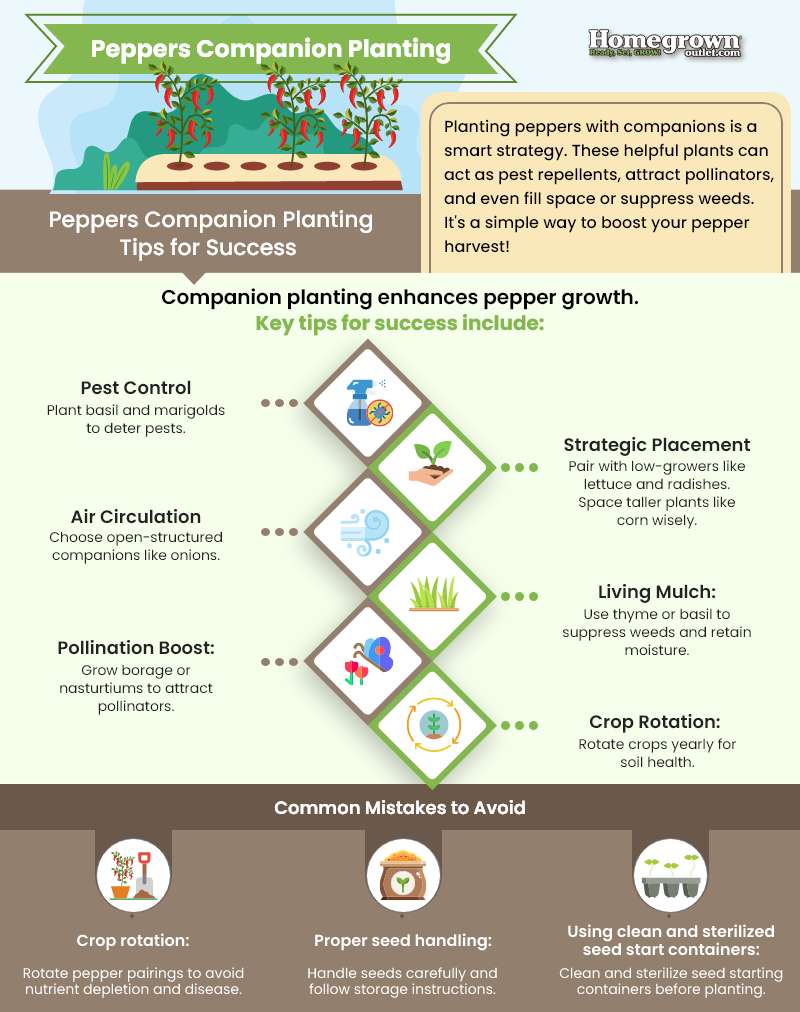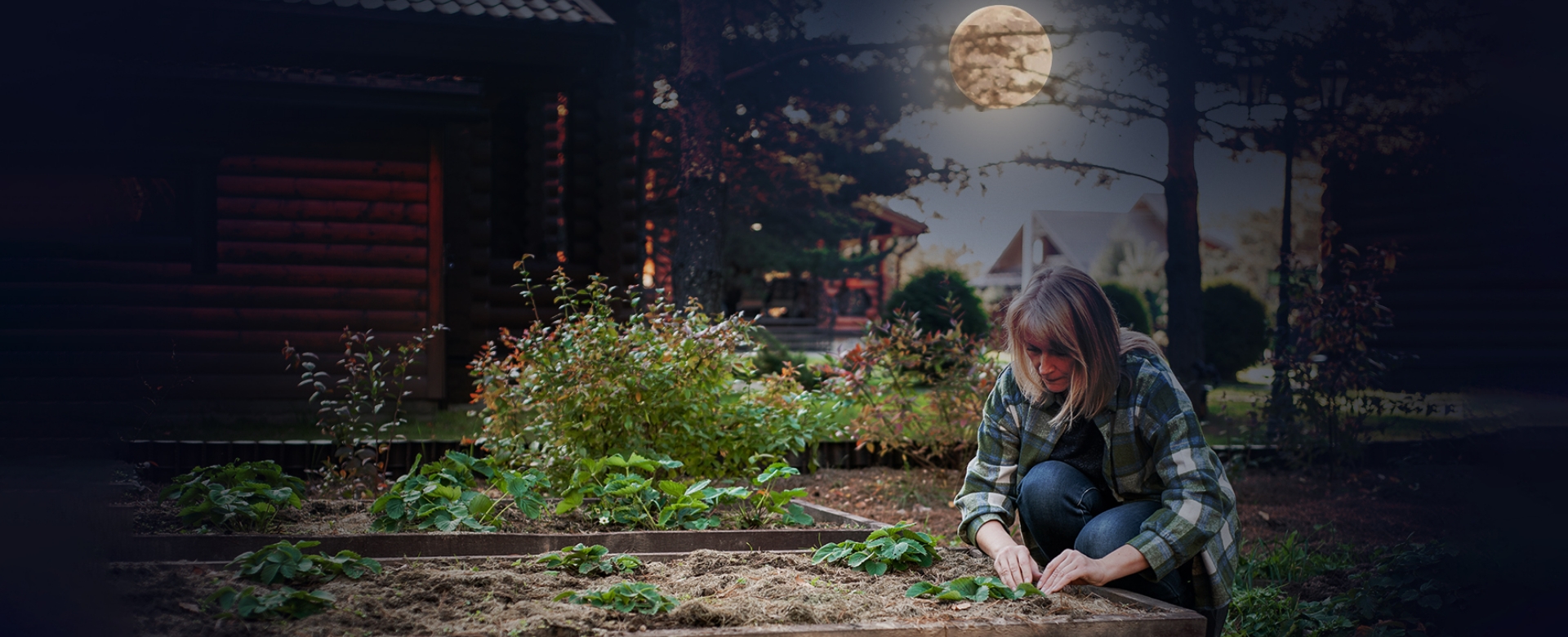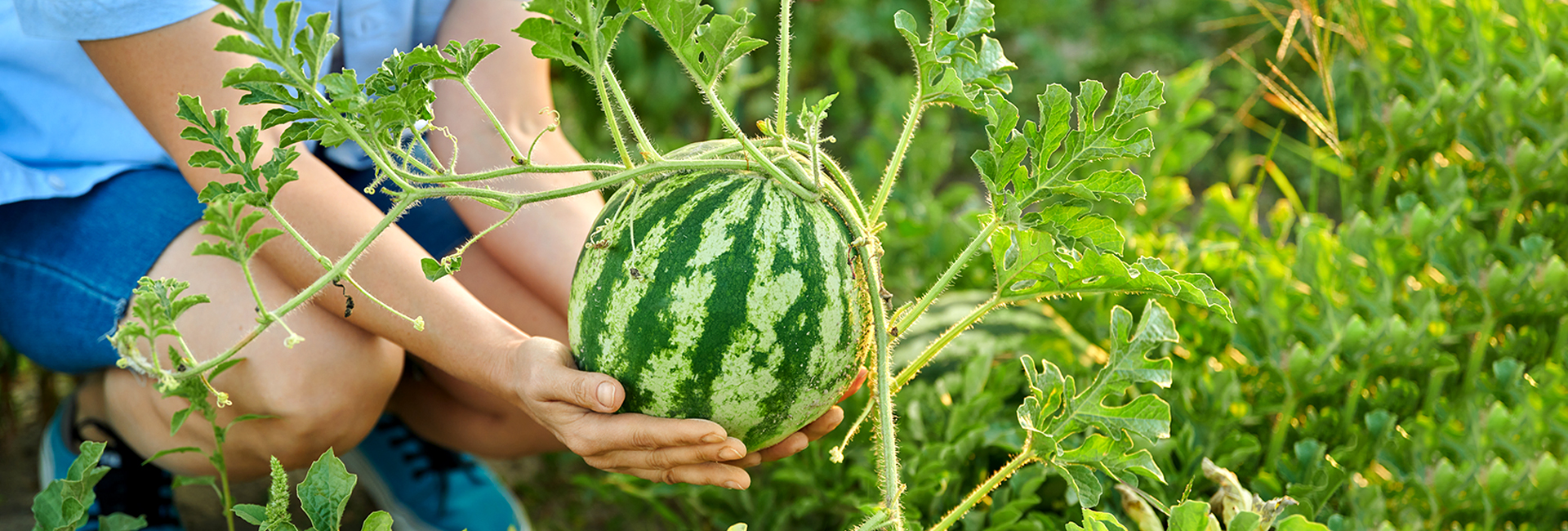Struggling with stunted pepper plants, pesky aphids, or disappointing yields?
You’re not alone. Although peppers are easy to grow, this tender annual needs the right conditions for best results. Aside from a sunny location and well-draining soil, there might be a secret weapon to make this year’s harvest the best yet: companion planting.
This natural strategy uses the power of plant partnerships to create a thriving ecosystem in your garden. What’s the best pepper companion plants to use? Our guide features the best companion plants for peppers, as well as plants to avoid and tips for success.
What Are Pepper Companion Plants?
Companion planting groups beneficial plants together. For example, you might plant peppers (heat-loving and bushy) next to basil, a fragrant herb that deters common pepper pests.
Ultimately, companion plants serve many purposes. Some attract helpful insects like ladybugs that gobble up aphids, while others deter harmful pests with their strong scents (like basil).
Some companion plants, like beans, even fix nitrogen in the soil, and peppers need a lot of nitrogen to maximize yields. Ultimately, companion planting may even influence flavor, like using carrots as a tomato companion plant, which maximize nutrient absorption for the plant.
Benefits of Companion Planting for Peppers
Imagine a thriving pepper patch teeming with life! Companion planting can help you achieve just that. By strategically grouping plants, there are many benefits of companion planting for peppers.
Some of the most common include:
- Healthier pepper plants: Beneficial insects keep pests at bay, while nitrogen-fixing companions promote strong growth.
- Increased yields: A healthy pepper plant is a happy pepper plant, leading to more delicious peppers for you to enjoy. Basil, for instance, is an effective companion for peppers that attracts pollinators (a major driver of yields).
- Reduced pests: Companion planting with peppers attracts natural predators and deters unwanted visitors. Pungent herbs, for example, may act as a deterrent, while certain flowers can attract insects that eat common pests.
- Different root systems: Pepper companion planting allows you to introduce deep-rooted plants. This can help with soil compaction and even improve nutrient uptake, resulting in healthier soil.
Best Companion Plants for Peppers

Want to try companion planting in your pepper patch this summer? These easy-to-grow herbs, flowers, and veggies are perfect pepper pals!
Try these as companion plants:
1. Basil
This fragrant herb repels flies and attracts pollinators, while its growth habit allows it to coexist peacefully with peppers. This pair is also great when it comes time to harvest. Peppers and basil are common pairs in Italian and Thai cuisine, for instance.
2. Marigolds
Marigolds are a useful companion plant for many vegetables, including peppers. Here’s why: These cheerful flowers deter harmful nematodes and add a splash of color to your garden.
3. Onions
Pungent onions provide protection for peppers. Their strong scent repels aphids, a common pepper pest.
Plus, they also offer space saving benefits. You can plant onions in between rows of peppers, for example, as they’re relatively low-growing and won’t shade out the sun-loving peppers. In addition, they’re also a great pepper companion plant, because they don’t utilize a lot of nutrients.
4. Nasturtiums
These vibrant flowers attract aphids and act as a “trap crop”. You’re thinking: Shouldn’t I avoid attracting aphids? Well, aphids are one of the most common pepper pests. However, nasturtiums are a favorite aphid food source.
As a result, they’ll be much more likely to attack the flowers, rather than your peppers. This is a useful strategy if you’ve had aphid problems in the past.
5. Carrots
Carrots are great companion plants for peppers and tomatoes. First, they’re relatively space-saving and you might find success planting them in between rows.
Plus, carrot roots dig deep into the soil. This can help with compaction issues and improve nutrient uptake from deeper in the soil for pepper plants.
6. Bush Beans
Legumes are one of the best nitrogen fixers in the garden. And this can be beneficial for nitrogen-loving pepper plants. However, you’ll want to choose a bush variety. Runner beans sprawl (taking up lots of space) or grow up trellises (shading out pepper plants).
Some of my favorites are Royal Burgundy beans, disease-resistant and easy to grow. Or black turtle beans (which are the perfect pair for garden-fresh Mexican dishes).
7. Corn
Although peppers love sun and heat, they’re not always happy in peak sun. Corn can offer a bit of afternoon shade, if planted correctly. Generally, though, you don’t want to shade them too much.
Plant corn about 18 inches away from pepper plants and consider a dwarf variety. I’ve enjoyed growing the Hudson Valley Seed Company’s Dwarf Blue Jade Sweet Corn as a companion plant.
8. Spinach
This leafy green thrives in cooler weather, so you can’t use it a companion plant all summer long. However, when you’re starting peppers in late spring or if you have space next to your peppers in the fall, spinach makes a good companion for un-used space.
9. Chives
Chives are a perennial that come back year-after-year. A great companion plant you can use again and again.
Here’s why chives are good pepper companions: Their delicate flowers attract pollinators, and their strong scent repels some pests. They’re also space-saving and fairly low-growing. If you’re looking for a spot in your garden, consider planting peppers near your chives.
10. Borage
Borage flowers are a magnet for bees and other beneficial insects, and the plant’s leaves are even edible! As a companion plant, you might want to use successive planting for your borage. It’s a fast grower, so succession planting will ensure a steady supply of blooms to attract pollinators.
Bad Companion Plants for Peppers

Any plants you shouldn’t grow next to peppers? A few rules: Don’t choose a companion plant that’s susceptible to similar diseases, that will compete for nutrients, or that will overcrowd your pepper plants.
Here are some of the worst companion plants for peppers:
1. Fennel: This fast-growing plant can crowd out your peppers and compete for resources.
2. Kohlrabi: Like fennel, kohlrabi has allelopathic properties that can hinder pepper growth.
3. Potatoes: Both peppers and potatoes are susceptible to similar diseases, so planting them together increases the risk of infection.
4. Eggplant: Peppers and eggplants are nightshade relatives that share some of the same pest and disease vulnerabilities.
5. Asparagus: Asparagus is a heavy feeder and can deplete the soil of nutrients needed by peppers.
6. Cucumbers: While cucumbers and peppers can technically coexist, their watering needs differ, making it a less-than-ideal pairing.
7. Dill: Some sources suggest dill may inhibit pepper growth, so it’s best to err on the side of caution.
8. Parsley: Like dill, parsley may not be the best companion for peppers.
9. Fennel: This fast-growing plant can crowd out your peppers and compete for resources. (We mentioned fennel earlier, but it’s such a bad companion it deserves double the warning!)
10. Walnuts: Black walnut trees release juglone, a toxin that can harm peppers and other plants.
Pepper Companion Planting Tips for Success
Companion planting is easy to learn and start with. However, following basic guidelines can help you be more successful.
As you choose and plant companions with your peppers, think about:
1. Attract the good guys
Choose companion plants that deter pests that love peppers. Consider herbs like basil, which repels aphids and flies, or marigolds, which discourage nematodes and other soil pests.
You can also think about trap crops to attract common pests away from pepper plants.
2. Space strategically
Be mindful of mature plant sizes. Plant low-growing companions like lettuce or radishes around pepper stems to utilize space without blocking sunlight.
Taller plants like corn can work too but place them further away or stagger them to avoid excessive shading. You also don’t want to choose a plant that will sprawl and compete with peppers for resources.
3. Maximize air circulation
A common misconception about companion planting: It’s all about fitting as many plants in a bed as possible. But here’s the problem: Overcrowding = poor air circulation, which is the No. 1 cause of fungal diseases.
One option: Choose plant companions with open structures like onions or bush beans to allow air to flow freely around pepper plants.
4. Living mulch and weed control
Use low-growing, sprawling herbs like thyme or oregano as living mulch. Basil is another good one that can trap humidity, which peppers love. Just make sure the basil doesn’t grow too tall and shade out your peppers.
Using herbs as a living mulch will suppress weeds and retain moisture in the soil, benefiting both the peppers and the herbs themselves.
5. Beneficial blooms
Successful pollination is key to a bountiful pepper harvest. That’s why blooming companions’ borage or nasturtiums make such good companions for peppers. Their blooms attract pollinators like bees and butterflies, which can improve fruit set on your pepper plants.
6. Rotate your crops
Don’t plant the same crops together year after year. Practice crop rotation to prevent soil-borne diseases and nutrient depletion. You might choose to plant peppers and basil together one season, and peppers and borage the next.

Common Mistakes to Avoid
The biggest mistake to avoid is choosing an incompatible neighbor. Some pepper varieties like habanero can tolerate and may even prefer drier conditions. Therefore, you don’t want to plant habaneros next to vegetables that prefer wet soil, like brassicas (cabbage, broccoli, etc.)
The next biggest mistake: Neglecting pest control. Although companion planting can reduce pest pressure, there are many pepper pest control methods you can continue to use. Like:
- Crop rotation
- Proper seed handling
- Using clean and sterilized seed start containers
Conclusion
Bottom line, companion planting is a win-win for you and your pepper patch. Not only will it help you protect your crop, but it’s also one of the best ways to maximize harvests overall. You’ll get more peppers, while saving space.
Interested in more companion planting tips? See our guide to blueberry companion planting.
Get your gardening supplies from Homegrown Outlet. Visit a location near you today for seeds, organic growing supplies, and more.
FAQs
This is a common question with conflicting answers. Really it depends on your goals. Peppers and tomatoes are both members of the nightshade family, so they’re susceptible to the same diseases. So if you do plant them together, keep up with pest control.
The strong scent of tomatoes can help deter some pepper pests, while peppers may mask the scent of tomatoes attracting whiteflies. To minimize disease risk, practice crop rotation and ensure proper spacing and air circulation between plants.
Companion planting is a wonderful strategy for natural pest control, but it's not a silver bullet. Beneficial insects attracted by companion plants can help reduce pest populations, but it might not eliminate them entirely. Depending on the severity of the infestation, you may still need to use organic pest control methods.
There's no scientific evidence to directly link basil to enhanced pepper flavor. However, some gardeners believe the close proximity can create a subtle flavor exchange. Basil does repel flies that might otherwise bother your peppers, so it's a win-win for pest control and creating a pleasant aromatic environment for both plants.
Some sources advise against planting dill near peppers due to potential allelopathic effects (where plants release chemicals that inhibit the growth of others). However, many gardeners haven't experienced issues planting them together. If you're unsure, err on the side of caution and plant them further apart or in separate containers.




